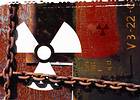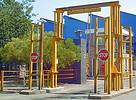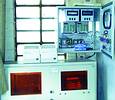

Radiation is a form of energy that comes from atoms, the building blocks of all matter and is around us at all times. The hazards that come to mind when you think of radiation are most often associated with what is called ‘ionising radiation’. We are all exposed to ionising radiation every day. In fact natural background radiation from soil, rocks, and cosmic rays, contribute about two-thirds of our radiation exposure. We are also exposed to several man-made sources of ionising radiation. These include television picture tubes, computer monitors, having an X-ray at our doctors – or even wearing certain luminous dial watches. Other exposures come to us via cosmic and terrestrial rays.
Most ionising radiation results when the structure of atoms breaks down. This can happen when another form of ionising radiation impinges on a normal atom, or when an unstable atom (usually classified as a radioisotope) decays or breaks down on its own. Radioisotopes release energy in the form of ionising radiation continuously, at a decaying rate, until all atoms become stable.
The way that an atom releases radiation can be compared to an old-style flashbulb. When the bulb is triggered energy is released as a flash of light. The bulb then changes its form to a spent bulb and is no longer capable of flashing. The release of ionising radiation is similar, except that there is no visible flash. A decaying atom gives off energy as radiation and then changes into a new form. However, unlike the flash bulb, you cannot see radiation and cannot tell whether the new atom is still decaying and capable of giving off radioactive energy. Each atom in a radioisotope sample may undergo several changes (and radiation releases) over a long period of time before finally reaching a stable form.
Main types of ionising radiation
Alpha radiation - these are large atomic particles emitted by both natural elements and some man-made substances. It has little external penetrating power, but can be harmful if you inhale or swallow dust or particles of these radioactive elements.
Beta radiation - fast moving atomic particles with little penetrating power - beta radiation sources are frequently used in medical or physical research environments.
Gamma radiation - electromagnetic waves resulting from radioactive decay - this has greater penetrating power than medical X-rays, and is often used in fixed and portable nuclear gauges.
Cosmic radiation -these are highly energetic atomic particles that originate from the sun and stars and penetrate the earth's atmosphere.
Neutron radiation - penetrating atomic particles that result from collisions between cosmic rays and atoms in the atmosphere, and from some specialised man-made sources - often used in portable nuclear gauges.
X-rays - machine generated electromagnetic waves that can penetrate the human body - this type of radiation is used primarily in hospitals and dentist's offices but is also used in some industrial environments.
Principles of radiation protection
Three factors come into play when protecting yourself from the dangerous effects of radiation: time, distance and shielding.
* Time: the less time a person remains in the area of the radiation, the less of the radiation dose that person will receive.
* Distance: the intensity of radiation and its effects fall off sharply as you move further away from the radioactive source, for example, by moving twice as far away from a radioactive source, you are exposed to one-quarter the amount of radiation, moving three times as far away means one-ninth the exposure and so on (inverse square function).
* Shielding: protective material placed between you and the source reduces the level of radiation passing through and thus the amount to which you will be exposed. In the case where a nuclear isotope is used as a radiation source, the source housing provides this screening.
(All of the above issues are published in the US Nuclear Regulatory Commission NUREG/BR - 0133 Rev 1).
There are still many problems pertaining to environmental health hazards around the world and also in South Africa. As industrial instrumentation people there are measurements and methods that can prevent radioactive materials (man-made or of naturally occurring) from entering our factories.
The main industries concerned about accepting unwanted radioactive material are the steel and foundry factories and the scrap metal businesses. The reasons are firstly, steel mills do not want to melt any radioactive material with the scrap, as it would radiate the metals that they are making, and secondly, they do not wish to contaminate their site or factory. The latter would give rise to serious environmental issues with their employees and local housing areas. The scrap metal businesses also do not want to sell radioactive products to the factories, as they could be held responsible for the radioactive state of the materials that they deliver.
"The presence of uranium and/or thorium in many of the South African ore deposits, causes a significant amount of metal scrap from mining and minerals processing operations to be contaminated with naturally occurring radioactivity. The contamination often accumulates in the scale on the inside of pipes, pumps and vessels. Scrap from underground areas seems to be mainly contaminated with uranium-containing scales while scales from processing plants may also contain other nuclides from uranium from the uranium and thorium series. Scales from pyrite-burning sulphuric acids plants seem to be enriched in lead and especially radium nuclides."
(Dr G. P. de Beer, Atomic Energy Corporation of SA, 'The melting of ateel contaminated with naturally occurring radioactivity'.)
As part of the test, truckloads from a mine were driven through a Ronan scrap detection system and all three loads activated the alarm at different alarm levels from 1 to 5.
Radioactive scrap detection system
This system had been evaluated previously and alarmed at gamma dose rates from 0,02-0,04 micro Sieverts/Hr depending on the gamma energy, this device seems to offer the best option as a scanning device, it did alarm all three trucks arriving from the mine.
NaI-detectors (handheld radioactivity monitors) were seen to be less successful as a scanning device. Most of the readings on the scrap dump were significantly above background. The readings were however quite variable. To set a screening level with such variability will be rather difficult. The aim of the investigation was to find a practical scanning mechanism (bulk gamma) to verify whether scrap may be acceptable for melting.
Dr de Beer also reported on 'experiments performed on the Ronan radioactive detection system'.
The Ronan X96 RSD Radioactive Scrap Detection System consists of extended plastic scintillation detectors installed as a frame above, below, left and right of a drive way for motor trucks. Background counts are continuously registered, and the counter is activated to start counting when a truck enters the detector frame.

Detection signals from background radiation as well as from gamma rays emitted by radioactive sources are counted over time intervals of 125 ms. The counts are evaluated statistically by a microprocessor. Alarms are activated at six different signal levels based on a number of consecutive readings above specified fraction or multiple of the background standard deviation. False alarms are restricted by the activation of background alarms when background variations exceed values, more details on the detection system is available from the suppliers.
Industrial radiation sources
In terms of industrial gamma-ray sources, the detection system proved to be a powerful instrument which should prevent all normal industrial gamma sources from being recycled. Only in extreme cases where sources are vastly 'over shielded', may sources not be detected. Such events will however be extremely unlikely.
It can therefore be seen that steel smelters, foundries and scrap metal merchants could make a great difference and benefit the environment significantly if such units where installed. In South Africa The Department of Health and Population authorise the use of man-made isotopes such as CS137, CO60 etc, many are lost or stolen on an annual basis, from their installations. The NNR (National Nuclear Regulator) is responsible for all naturally occurring radioactive materials. Should you have any radioactive problems on site, this would be the government department to contact.
There are currently 18 Ronan radioactive scrap detection systems installed in South Africa in scrap yards, steel mills and foundries either on their road or rail weigh bridge - assisting in creating a 'radiation free South African environment'.

For more information contact Steve Smith, director, Radiation Protection Services, Exact Measurement & Control, 016 976 2112, [email protected]

© Technews Publishing (Pty) Ltd | All Rights Reserved